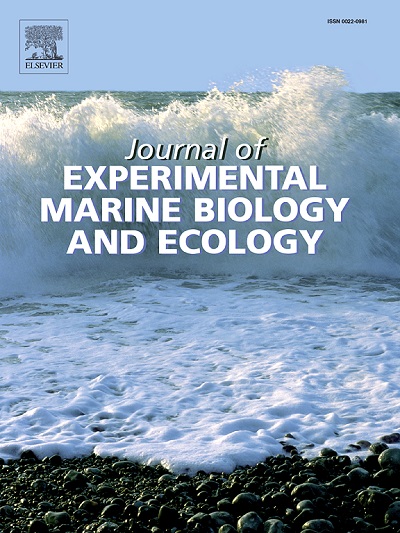海洋酸化及猎物脂肪酸改变对北岩比目鱼(Lepidopsetta polyxystra)幼虫早期发育的影响
IF 1.8
3区 生物学
Q3 ECOLOGY
Journal of Experimental Marine Biology and Ecology
Pub Date : 2025-05-27
DOI:10.1016/j.jembe.2025.152111
引用次数: 0
摘要
海洋酸化(OA)预计会影响鱼类和无脊椎动物幼体的生理速率,并通过改变食物网对海洋渔业产生重大影响。我们研究了北岩比目鱼(Lepidopsetta polyxystra)的死亡率、体型和初次取食幼虫的状况是否受到猎物质量(必需脂肪酸)和高二氧化碳(CO2)暴露的协同影响。将幼虫暴露于环境和高CO2水平(~ 330 μatm vs. 1020 μatm)中,并在孵化后立即饲喂平衡或不平衡EFA比例的饲粮7周。2周后,观察到CO2和饲料的显著影响,其中最大的幼虫出现在高CO2暴露组,接受平衡的EFA饲料。暴露5周后,升高的CO2对幼虫大小的影响减弱,但与喂食不平衡的EFA饲料的幼虫相比,喂食平衡EFA饲料的幼虫保持了更高的脂肪基础条件指标。在不同的重复试验中,存活率是可变的,不同处理之间没有显著差异。本研究表明,多xystra L.幼虫在发育的不同阶段最容易受到OA和食物网变化的影响。为了预测OA对北岩比目鱼渔业的影响,需要进一步了解这些生态系统的影响。本文章由计算机程序翻译,如有差异,请以英文原文为准。
Impacts of ocean acidification and altered prey fatty acids on the early development of northern rock sole (Lepidopsetta polyxystra) larvae
Ocean acidification (OA) is predicted to affect the physiological rates of larval fish and invertebrates and is also expected to significantly impact marine fisheries through alteration of food webs. We examined whether mortality rates, body size, and condition of first-feeding larval northern rock sole, Lepidopsetta polyxystra, were synergistically influenced by prey quality (essential fatty acids, EFAs) and high carbon dioxide (CO2) exposure. Larvae were exposed to ambient and high CO2 levels (∼ 330 vs. 1020 μatm) and were fed diets with balanced or unbalanced EFA ratios for 7 weeks immediately following hatch. After 2 weeks, significant effects from CO2 and diet were observed, with the largest larvae occurring in the high CO2 exposure group that received a balanced EFA diet. After 5 weeks of exposure, the effects of elevated CO2 had a diminished impact on larval size, but larvae reared on the balanced EFA diet maintained higher lipid-based condition metrics than those fed an unbalanced EFA diet. Survival was variable across replicate tanks and not significantly different between treatments. This study suggests that L. polyxystra larvae are most vulnerable to OA and food web change at different points in their development. Further understanding of these ecosystem effects will be required to predict the impacts of OA on northern rock sole fisheries.
求助全文
通过发布文献求助,成功后即可免费获取论文全文。
去求助
来源期刊
CiteScore
4.30
自引率
0.00%
发文量
98
审稿时长
14 weeks
期刊介绍:
The Journal of Experimental Marine Biology and Ecology provides a forum for experimental ecological research on marine organisms in relation to their environment. Topic areas include studies that focus on biochemistry, physiology, behavior, genetics, and ecological theory. The main emphasis of the Journal lies in hypothesis driven experimental work, both from the laboratory and the field. Natural experiments or descriptive studies that elucidate fundamental ecological processes are welcome. Submissions should have a broad ecological framework beyond the specific study organism or geographic region.
Short communications that highlight emerging issues and exciting discoveries within five printed pages will receive a rapid turnaround. Papers describing important new analytical, computational, experimental and theoretical techniques and methods are encouraged and will be highlighted as Methodological Advances. We welcome proposals for Review Papers synthesizing a specific field within marine ecology. Finally, the journal aims to publish Special Issues at regular intervals synthesizing a particular field of marine science. All printed papers undergo a peer review process before being accepted and will receive a first decision within three months.

 求助内容:
求助内容: 应助结果提醒方式:
应助结果提醒方式:


